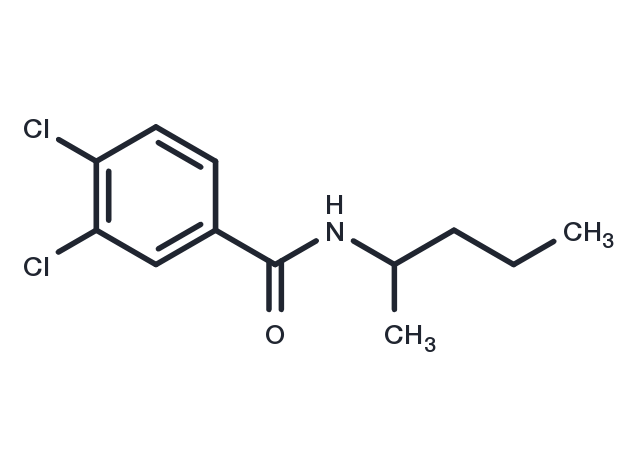Powder: -20°C for 3 years | In solvent: -80°C for 1 year


NSC 405020 is a noncatalytic inhibitor of MT1-MMP.

| Pack Size | Availability | Price/USD | Quantity |
|---|---|---|---|
| 5 mg | In stock | $ 41.00 | |
| 10 mg | In stock | $ 63.00 | |
| 25 mg | In stock | $ 127.00 | |
| 100 mg | In stock | $ 361.00 | |
| 200 mg | In stock | $ 545.00 | |
| 1 mL * 10 mM (in DMSO) | In stock | $ 50.00 |



| Description | NSC 405020 is a noncatalytic inhibitor of MT1-MMP. |
| In vitro | NSC 405020 is a noncatalytic inhibitor of MT1-MMP, directly interacts with PEX domain of MT1-MMP. NSC 405020 affects PEX homodimerization but not catalytic activity of MT1-MMP. NSC 405020 (100 μM) inhibits migration of cells with high level of MT1-MMP, with a reduction of migration efficiency by about 75%. NSC 405020 does not inhibit migration of cells with low level of MT1-MMP and does not inhibit cell adhesion on collagen.[1] |
| In vivo | NSC 405020 (0.5 mg/kg, intratumoral injection) significantly represses tumor growth. NSC 405020 causes a fibrotic, ΔPEX-like tumor phenotype and increases the level of COL-I. [1] |
| Kinase Assay | Migration assays: Assays are conducted in wells of a 24-well, 8 μm pore size Transwell plate. A 6.5-mm insert membrane is coated with 0.1 mL COL-I (300 μg/mL in MEGM) and then air dried for 16 hours. The collagen coating is rehydrated for 1 hour in 0.2 mL MEGM. The inner chamber contains MEGM-10% FBS as a chemoattractant. The compounds (10–100 μmol/L) or DMSO (0.1%–1%) are added to both inner and outer chambers. Before plating in the outer chamber, cells (5×104) are coincubated for 20 minutes with the compounds or DMSO in MEGM. Cells are allowed to migrate for 16 to 18 hours. The cells remaining on the top surface of the membrane are removed with a cotton swab. The cells on the bottom surface of the membrane are fixed and stained (0.2% crystal violet). The incorporated dye is extracted with 1% SDS and the A570 is measured. |
| Cell Research | Assays are conducted in wells of a 96-well flat bottom, white wall plates. 184B5-MT and MCF7-β3/MT cells (5×104) are grown for 16 hours in MEGM-10% FBS and DMEM-10% FBS, respectively. 184B5-MT cells are replenished with fresh MEGM (0.1 mL per well) and incubated for an additional 24 hours in the presence of the compounds (100 μM) or vehicle (1% DMSO). MCF7-β3/MT cells are replenished with fresh DMEM-10% FBS (0.1 mL per well) and incubated for an additional 6 hours in the presence of the compounds (400 μM) or vehicle (2% DMSO). The viable cells are counted using a luminescent ATP-Lite assay.(Only for Reference) |
| Molecular Weight | 260.16 |
| Formula | C12H15Cl2NO |
| CAS No. | 7497-07-6 |
Powder: -20°C for 3 years | In solvent: -80°C for 1 year
DMSO: 26 mg/mL (100 mM)
Ethanol: 26 mg/mL (100 mM)
You can also refer to dose conversion for different animals. More
bottom
Please see Inhibitor Handling Instructions for more frequently ask questions. Topics include: how to prepare stock solutions, how to store products, and cautions on cell-based assays & animal experiments, etc.
NSC 405020 7497-07-6 Proteases/Proteasome MMP NICD3 WM852 cells vestibular schwannoma NSC-405020 inhibit Notch3 thrombosis Inhibitor Matrix metalloproteinases NSC405020 hemostasis inhibitor
